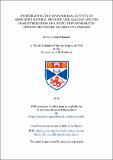Files in this item
Investigating the trypanocidal activity of simplified natural product-like analogs and the characterization of a novel trypanosomatid-specific secondary alternative oxidase
Item metadata
| dc.contributor.advisor | Smith, Terry K. | |
| dc.contributor.advisor | Florence, Gordon John | |
| dc.contributor.author | Menzies, Stefanie Kate | |
| dc.coverage.spatial | xxviii, 252 p. | en_US |
| dc.date.accessioned | 2017-11-09T16:23:49Z | |
| dc.date.available | 2017-11-09T16:23:49Z | |
| dc.date.issued | 2017-12-07 | |
| dc.identifier.uri | https://hdl.handle.net/10023/12041 | |
| dc.description.abstract | This thesis aimed to identify the trypanocidal mode of action of non-natural chamuvarinin analogs, and to assess the previously uncharacterized secondary alternative oxidase (AOX2) as a possible drug target of the trypanosomatids. The drugs used to treat infections with Trypanosoma brucei, Trypanosoma cruzi and Leishmania spp. are highly toxic and are increasingly becoming less effective as the parasites develop resistance, therefore new drugs against the diseases are desperately needed. Non-natural analogs of chamuvarinin were tested for trypanocidal activity to determine the structure activity relationships of the compounds against insect-form T. cruzi and Leishmania spp. This identified several potent and selective analogs, which retained good activity against the medically relevant intracellular forms of the parasites. Photoaffinity labeling was utilized to identify the mode of action and protein target(s) of the chamuvarinin analogs. The analogs were shown to deplete ATP levels and to induce mitochondrial dysmorphia and mitochondrial oxidative stress. Photoaffinity labeling confirmed the mitochondrial localization of the protein target(s) of these compounds, however the exact protein target(s) were unable to be identified by protein pull-down and mass spectrometry. The previously uncharacterized secondary alternative oxidases (AOX2) are conserved throughout the human-infective trypanosomatids and are absent from mammalian cells, thus making an attractive drug target if the protein is essential. The AOX2 of T. brucei, T. cruzi and L. major were expressed in Escherichia coli to characterize the enzymatic activity of the proteins. T. brucei AOX2 was successfully purified and shown to be an ubiquinol oxidase, which contains bound iron (III). The role of AOX2 within the trypanosomatids was determined by biochemical phenotyping and genetic manipulation of T. brucei, T. cruzi and L. major, which indicated that AOX2 is an essential mitochondrial oxidase in the three trypanosomatids, with a putative role in energy production, and therefore is an attractive multi-trypanosomatid drug target. | en_US |
| dc.language.iso | en | en_US |
| dc.publisher | University of St Andrews | |
| dc.subject | Trypanosome | en_US |
| dc.subject | Drug discovery | en_US |
| dc.subject | Target identification | en_US |
| dc.subject | Mitochondria | en_US |
| dc.subject | Alternative oxidase | en_US |
| dc.subject | Leishmania | en_US |
| dc.subject.lcc | QL368.K5M46 | |
| dc.subject.lcsh | Drug development. | en |
| dc.subject.lcsh | Trypanosoma brucei. | en |
| dc.subject.lcsh | Trypanosoma cruzi. | en |
| dc.subject.lcsh | Leishmaniasis. | en |
| dc.title | Investigating the trypanocidal activity of simplified natural product-like analogs and the characterization of a novel trypanosomatid-specific secondary alternative oxidase | en_US |
| dc.type | Thesis | en_US |
| dc.contributor.sponsor | Leverhulme Trust | en_US |
| dc.type.qualificationlevel | Doctoral | en_US |
| dc.type.qualificationname | PhD Doctor of Philosophy | en_US |
| dc.publisher.institution | The University of St Andrews | en_US |
| dc.identifier.doi | https://doi.org/10.17630/10023-12041 |
This item appears in the following Collection(s)
Items in the St Andrews Research Repository are protected by copyright, with all rights reserved, unless otherwise indicated.

